Heinrich J.G., Aldinger F. (Eds.) Ceramic Materials and Components for Engines
Подождите немного. Документ загружается.

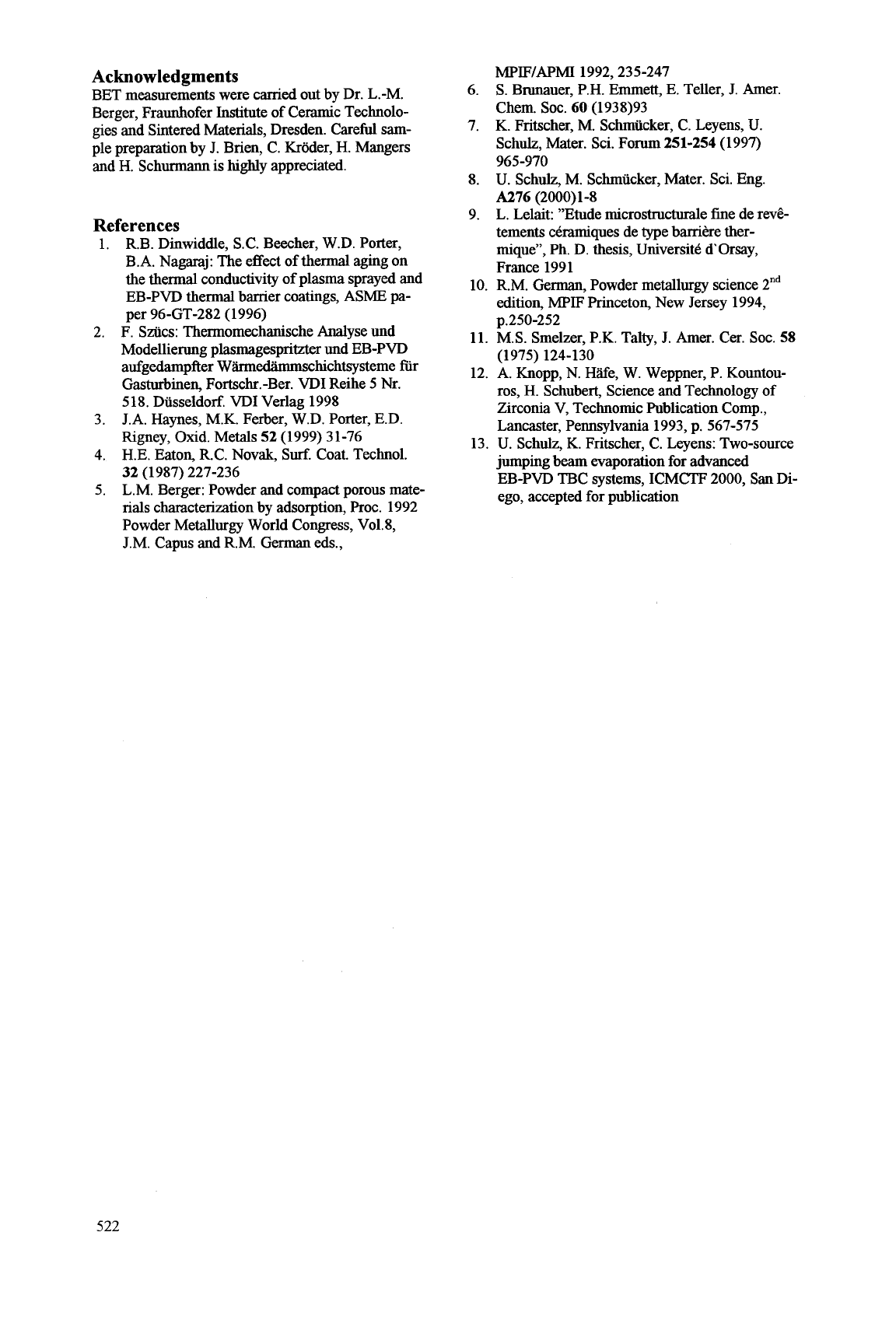
Acknowledgments
BET measurements were carried out by Dr. L.-M.
Berger, Fraunhofer Institute of Ceramic Technolo-
gies and Sintered Materials, Dresden.
Careful
sam-
ple preparation by J. Brien, C. Kroder, H. Mangers
and H. Schurmann
is
highly appreciated.
References
1.
2.
3.
4.
5.
R.B. Dinwiddle, S.C. Beecher, W.D. Porter,
B.A. Nagaraj: The effect of thermal aging on
the thermal conductivity of plasma sprayed and
EB-PVD thermal barrier coatings, ASME
pa-
per 96-GT-282 (1996)
F. Sziics: Thermomechanische Analyse und
Modellierung plasmagespritzter und EB-PVD
aufgedampfter Wi4rmedWmschichtsysteme
fiir
Gasturbinen, Fortschr.-Ber.
VDI
Reihe
5
Nr.
5
18. Dusseldorf.
VDI
Verlag 1998
J.A. Haynes, M.K. Ferber, W.D. Porter, E.D.
Rigney, Oxid. Metals
52
(1999) 31-76
H.E. Eaton, R.C. Novak,
Surf.
Coat. Technol.
L.M. Berger: Powder and compact porous mate-
rials characterization by adsorption, Roc. 1992
Powder Metallurgy World Congress, Vo1.8,
J.M. Capus and R.M.
German
eds.,
32
(1987) 227-236
6.
7.
8.
9.
MPIF/APMl
1992,235-247
S.
Brunauer, P.H. Emmett, E. Teller, J. Amer.
Chem. SOC.
60
(1938)93
K. Fritscher, M. Schmucker, C. Leyens, U.
Schulz, Mater.
Sci.
Forum
251-254
(1997)
U. Schulz, M. Schmucker, Mater.
Sci.
Eng.
L. Lelait: "Etude microstructurale fine de rev&
tements ceramiques de type baniere ther-
mique", Ph. D. thesis, Universite
d
Orsay,
France 1991
965-970
A276
(2OOO)l-8
10. R.M.
German,
Powder metallurgy science 2nd
edition,
MPIF
Princeton, New Jersey 1994,
11.
M.
S.
Smelzer, P.K. Talty, J. Amer. Cer. SOC.
58
12.
A.
Knopp, N. Htife, W. Weppner, P. Kountou-
ros, H. Schubert, Science and Technology of
Zirconia
V,
Technomic Publication Comp.,
Lancaster, Pennsylvania 1993, p. 567-575
13. U. Schulz, K. Fritscher, C. Leyens: Two-source
jumping beam evaporation for advanced
EB-PVD
TBC
systems, ICMCTF 2000, San Di-
ego, accepted for publication
p.250-252
(1975) 124-130
522
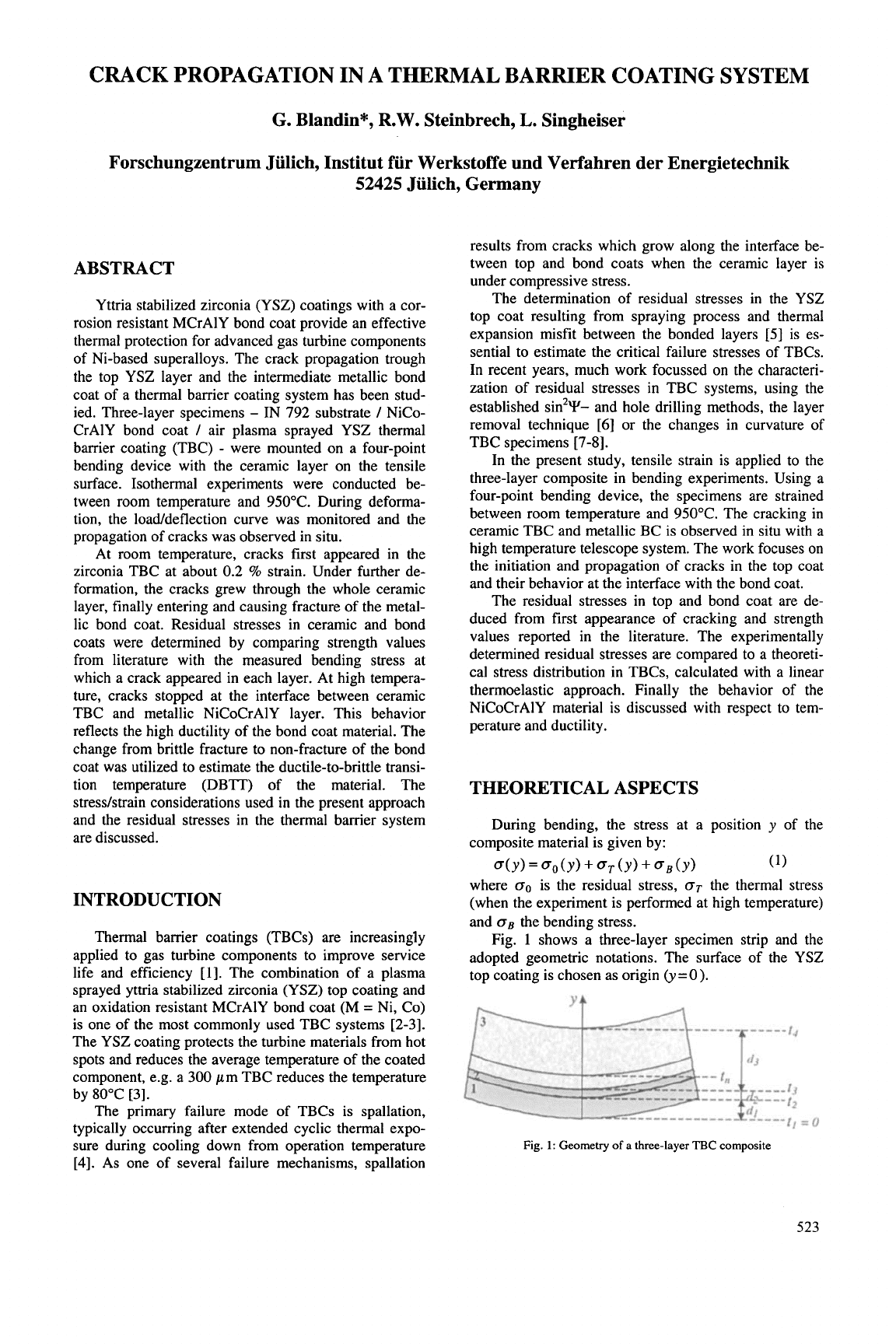
CRACK PROPAGATION IN A THERMAL BARRIER COATING SYSTEM
G.
Blandin*, R.W. Steinbrech,
L.
Singheiser
Forschungzentrum Julich, Institut fur Werkstoffe und Verfahren der Energietechnik
52425
Julich, Germany
ABSTRACT
Yttria stabilized zirconia (YSZ) coatings with a cor-
rosion resistant MCrAlY bond coat provide an effective
thermal protection for advanced gas turbine components
of Ni-based superalloys. The crack propagation trough
the top YSZ layer and the intermediate metallic bond
coat of a thermal barrier coating system has been stud-
ied. Three-layer specimens
-
IN 792 substrate
/
NiCo-
CrAlY bond coat
/
air plasma sprayed YSZ thermal
barrier coating (TBC)
-
were mounted on a four-point
bending device with the ceramic layer on the tensile
surface. Isothermal experiments were conducted be-
tween room temperature and 950°C. During deforma-
tion, the load/deflection curve was monitored and the
propagation of cracks was observed in situ.
At room temperature, cracks first appeared
in
the
zirconia TBC at about
0.2
%
strain. Under further de-
formation, the cracks grew through the whole ceramic
layer, finally entering and causing fracture of the metal-
lic bond coat. Residual stresses
in
ceramic and bond
coats were determined by comparing strength values
from literature with the measured bending stress at
which a crack appeared in each layer. At high tempera-
ture, cracks stopped at the interface between ceramic
TBC and metallic NiCoCrAlY layer. This behavior
reflects the high ductility of the bond coat material. The
change from brittle fracture
to
non-fracture of the bond
coat was utilized to estimate the ductile-to-brittle transi-
tion temperature (DBTT) of the material. The
stress/strain considerations used in the present approach
and the residual stresses in the thermal barrier system
are discussed.
INTRODUCTION
Thermal barrier coatings (TBCs) are increasingly
applied to gas turbine components to improve service
life and efficiency
[l].
The combination of a plasma
sprayed yttria stabilized zirconia
(YSZ)
top coating and
an oxidation resistant MCrAlY bond coat (M
=
Ni, Co)
is one of the most commonly used TBC systems
[2-31.
The YSZ coating protects the turbine materials from hot
spots and reduces the average temperature of the coated
component, e.g. a
300
pm TBC reduces the temperature
by 80°C
[3].
The primary failure mode of
TBCs
is
spallation,
typically occurring after extended cyclic thermal expo-
sure during cooling down from operation temperature
[4].
As one of several failure mechanisms, spallation
results from cracks which grow along the interface be-
tween top and bond coats when the ceramic layer is
under compressive stress.
The determination of residual stresses in the YSZ
top coat resulting from spraying process and thermal
expansion misfit between the bonded layers
[5]
is es-
sential to estimate the critical failure stresses of TBCs.
In recent years, much work focussed on the characteri-
zation of residual stresses in TBC systems, using the
established sin2'€'- and hole drilling methods, the layer
removal technique
[6]
or
the changes in curvature of
TBC specimens
[7-81.
In the present study, tensile strain is applied to the
three-layer composite in bending experiments. Using a
four-point bending device, the specimens are strained
between room temperature and 950°C. The cracking in
ceramic TBC and metallic BC is observed in situ with a
high temperature telescope system. The work focuses on
the initiation and propagation of cracks in the top coat
and their behavior at the interface with the bond coat.
The residual stresses in top and bond coat are de-
duced from first appearance of cracking and strength
values reported in the literature. The experimentally
determined residual stresses are compared to a theoreti-
cal stress distribution in TBCs, calculated with a linear
thermoelastic approach. Finally the behavior of the
NiCoCrAlY material is discussed with respect to tem-
perature and ductility.
THEORETICAL ASPECTS
During bending, the stress at a position
y
of the
composite material is given by:
where
b0
is the residual stress,
oT
the thermal stress
(when the experiment is performed at high temperature)
and
oE
the bending stress.
Fig.
1
shows a three-layer specimen strip and the
adopted geometric notations. The surface of the YSZ
top coating is chosen as origin
(y=O).
O(Y)
=
(y)
+
O'f
(Y)
+
OB
(Y)
(1)
Fig.
1:
Geometry
of
a three-layer
TBC
composite
523
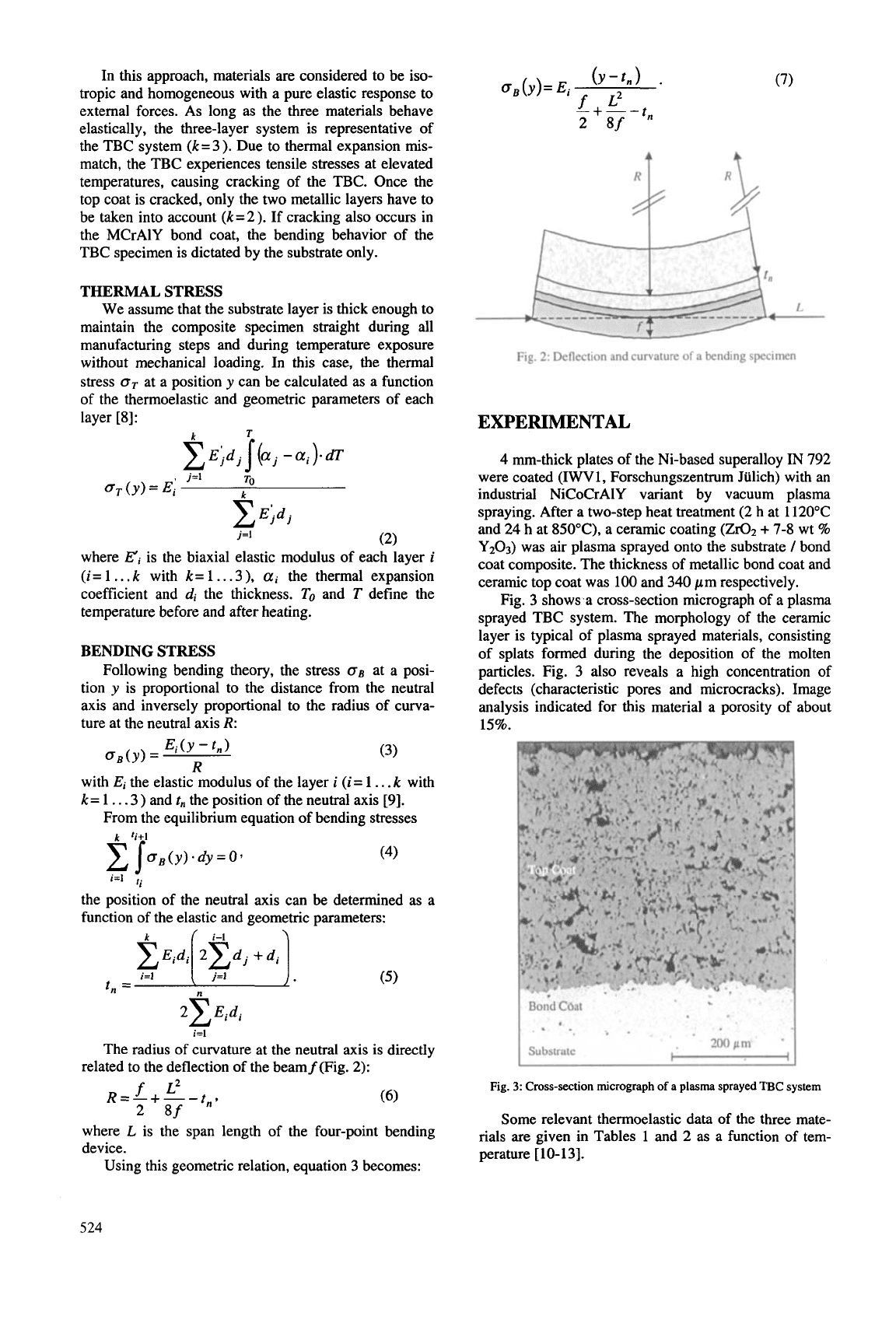
In this approach, materials are considered to be iso-
tropic and homogeneous with a pure elastic response to
external forces. As long as the three materials behave
elastically, the three-layer system is representative of
the TBC system
(k=3).
Due to thermal expansion mis-
match, the TBC experiences tensile stresses at elevated
temperatures, causing cracking of the TBC. Once the
top coat is cracked, only the two metallic layers have to
be taken into account
(k=2).
If cracking also occurs in
the MCrAlY bond coat, the bending behavior of the
TBC specimen is dictated by the substrate only.
THERMAL STRESS
We assume that the substrate layer is thick enough to
maintain the composite specimen straight during all
manufacturing steps and during temperature exposure
without mechanical loading. In this case, the thermal
stress at a position
y
can be calculated as a function
of the thermoelastic and geometric parameters of each
layer
[8]:
E)dj
~
(2)
j=l
where
Fi
is the biaxial elastic modulus of each layer
i
(i=l
...
k
with
k=l
...
3),
ai
the thermal expansion
coefficient and
di
the thickness.
To
and
T
define the
temperature before and after heating.
BENDING
STRESS
at a posi-
tion
y
is
proportional to the distance from the neutral
axis and inversely proportional to the radius of curva-
ture at the neutral axis
R:
Following bending theory, the stress
with
Ei
the elastic modulus of the layer
i
(i=
1
.
. .
k
with
k=
1
.
.
.3)
and
fn
the position of the neutral axis
[9].
From the equilibrium equation of bending stresses
i=l
ti
the position of the neutral axis can be determined as a
function of the elastic and geometric parameters:
AEidi[2gdj
+di\
i=I
\
j=1
I,
=
I
(5)
2c
Eidi
i=l
The radius of curvature at the neutral axis is directly
related to the deflection of the beam
f
(Fig.
2):
where
L
is the span length of the four-point bending
device.
Using this geometric relation, equation
3
becomes:
Fig.
2:
Deflection and curvature
of
a bending specimen
EXPERIMENTAL
4
mm-thick plates of the Ni-based superalloy IN
792
were coated
(IWV1,
Forschungszentrum Jiilich) with
an
industrial NiCoCrAlY variant by vacuum plasma
spraying. After a two-step heat treatment
(2
h at
112OOC
and
24
h at 850°C), a ceramic coating
(ZrOz
+
7-8
wt
%
Yz03) was air plasma sprayed onto the substrate
/
bond
coat composite. The thickness of metallic bond coat and
ceramic top coat was
100
and
340
pm
respectively.
Fig.
3 shows a cross-section micrograph
of
a plasma
sprayed TBC system. The morphology of the ceramic
layer is typical of plasma sprayed materials, consisting
of splats formed during the deposition of the molten
particles. Fig.
3
also reveals a high concentration of
defects (characteristic pores and microcracks). Image
analysis indicated for this material a porosity of about
15%.
.
-.
.
Substrale
I
Fig.
3:
Cross-section micrograph
of
a plasma sprayed
TBC
system
Some relevant thermoelastic data of the three mate-
rials
are
given in Tables
1
and
2
as a function of tem-
perature
[lo-131.
524
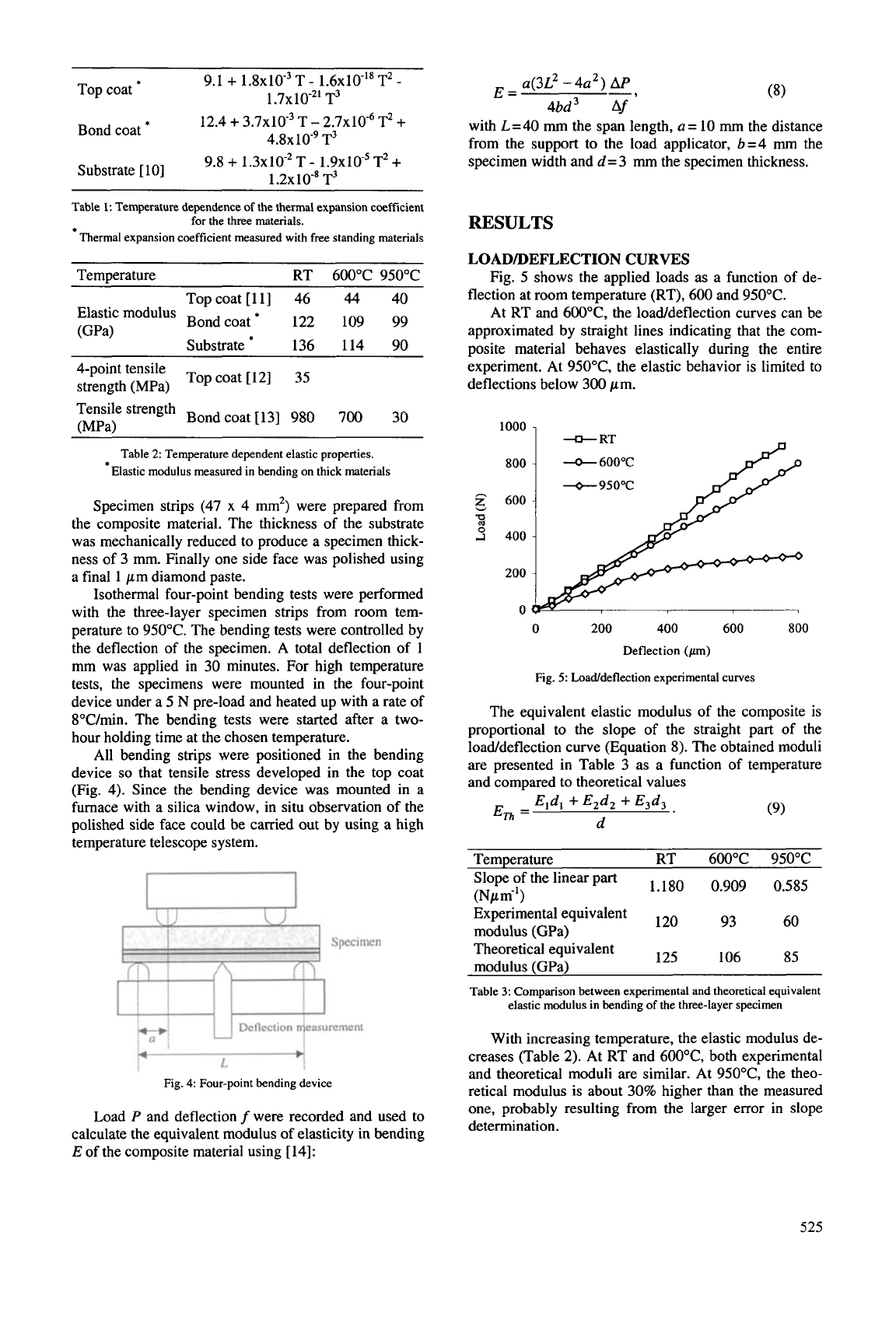
9.1
+
1.8~10'~ T
-
1.6~10-'~ T2
-
1.7~10-~' T3
Top coat
*
12.4
+
3.7~10" T
-
2.7~10-~ T2
+
4.8~10-~ T3
9.8
+
1.3~10-~ T
-
1.9x10-' T2
+
1.2~
1
O-*
T3
Bond coat
*
Substrate
[
101
Table
1:
Temperature dependence
of
the thermal expansion coefficient
for the three materials.
Thermal expansion coefficient measured with free standing materials
*
Temperature RT 600°C 950°C
Topcoat
[ll]
46
44
40
Bondcoat* 122 109 99
Elastic modulus
(GPa)
.I
Substrate
*
136 114 90
Top coat
[
121 35
4-point tensile
strength (MPa)
strength
Bond coat
[
131 980
(MPa)
700
30
.,
Table
2:
Temperature dependent elastic properties.
Elastic modulus measured in bending on thick materials
*
Specimen strips (47
x
4 mm2) were prepared from
the composite material. The thickness of the substrate
was mechanically reduced to produce a specimen thick-
ness of 3 mm. Finally one side face was polished using
a final 1 pm diamond paste.
Isothermal four-point bending tests were performed
with the three-layer specimen strips from room tem-
perature to 950°C. The bending tests were controlled by
the deflection of the specimen. A total deflection of 1
mm was applied in 30 minutes. For high temperature
tests, the specimens were mounted in the four-point
device under a
5
N pre-load and heated up with a rate of
8"C/min. The bending tests were started after a two-
hour holding time at the chosen temperature.
All bending strips were positioned in the bending
device
so
that tensile stress developed in the top coat
(Fig. 4). Since the bending device was mounted in a
furnace with a silica window, in situ observation of the
polished side face could be carried out by using a high
temperature telescope system.
Specimen
Fig.
4:
Four-point bending device
Load
P
and deflection
f
were recorded and used to
calculate the equivalent modulus of elasticity in bending
E of the composite material using
[
141:
(8)
43L2
-4a2)
-
AP
E=
4bd3
Af
'
with L
=
40
mm
the span length,
a
=
10
mm
the distance
from the support to the load applicator, b=4
mm
the
specimen width and
d=
3
mm the specimen thickness.
RESULTS
LOAD/DEFLECTION CURVES
Fig.
5
shows the applied loads as a function of de-
flection at room temperature (RT),
600
and 950°C.
At RT and 600"C, the loaddeflection curves can be
approximated by straight lines indicating that the com-
posite material behaves elastically during the entire
experiment. At 950"C, the elastic behavior is limited to
deflections below 300 pm.
1000
,
800
600
400
200
0
0
200
400
600
800
Deflection
(pm)
Fig.
5:
Loaddeflection experimental curves
The equivalent elastic modulus of the composite is
proportional to the slope of the straight part of the
loaddeflection curve (Equation
8).
The obtained moduli
are presented in Table
3
as a function of temperature
and compared
to
theoretical values
(9)
Eldl
+
E2d2
+
E3d3
.
d
ETh
=
Temperature RT 600°C 950°C
1.180 0.909
0.585
Slope of the linear part
(Npm-')
120 93 60
125 106
85
Experimental equivalent
modulus (GPa)
Theoretical equivalent
modulus (GPa)
Table
3:
Comparison between experimental and theoretical equivalent
elastic modulus in bending of the three-layer specimen
With increasing temperature, the elastic modulus de-
creases (Table 2). At RT and 6OO0C, both experimental
and theoretical moduli are similar. At 950"C, the theo-
retical modulus is about 30% higher than the measured
one, probably resulting from the larger error in slope
determination.
525
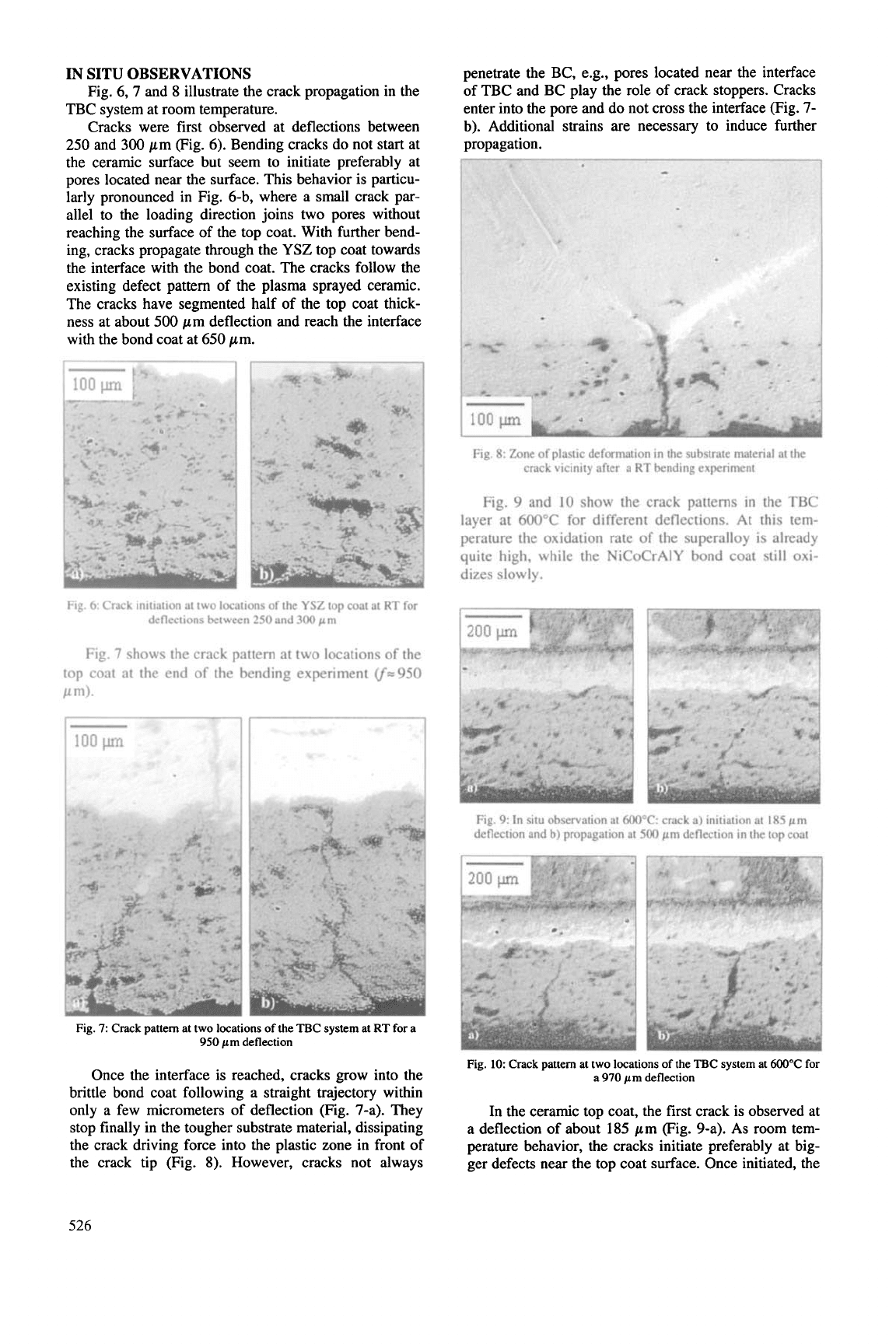
IN SITU OBSERVATIONS
Fig. 6,
7
and
8
illustrate the crack propagation in the
TBC system at room temperature.
Cracks were first observed at deflections between
250
and
300
pm (Fig.
6).
Bending cracks do not start at
the ceramic surface but seem to initiate Dreferablv at
penetrate the BC, e.g., pores located near the interface
of TBC and BC play the role of crack stoppers. Cracks
enter into the pore and do not cross the interface (Fig.
7-
b). Additional strains are necessary to induce further
propagation.
Fig.
6:
Crack initiation at two locations
of
the
YSZ
top coat at
RT
for
deflections between
250
and
300
pm
Fig.
7
shows the crack pattern at two locations of the
top coat at the end of the bending experiment
(f==950
pm).
Fig. 9: In situ observation at 600°C: crack a) initiation at 185
pm
deflection and
b)
propagation at
500
pm
deflection in the top coat
Fig. 7: Crack pattern at two locations
of
the TBC system a1
RT
for
a
950
pm
deflection
Fig.
10:
Crack pattern at two locations
of
the TBC system at 600°C
for
a 970 pm deflection
Once the interface is reached, cracks grow into the
brittle bond coat following a straight trajectory within
only a few micrometers of deflection (Fig. 7-a). They
stop finally in the tougher substrate material, dissipating
the crack driving force into the plastic zone in front of
the crack tip (Fig.
8).
However, cracks not always
In the ceramic top coat, the first crack is observed at
a deflection of about
185
pm (Fig. 9-a). As room tem-
perature behavior, the cracks initiate preferably at big-
ger defects near the top coat surface. Once initiated, the
526
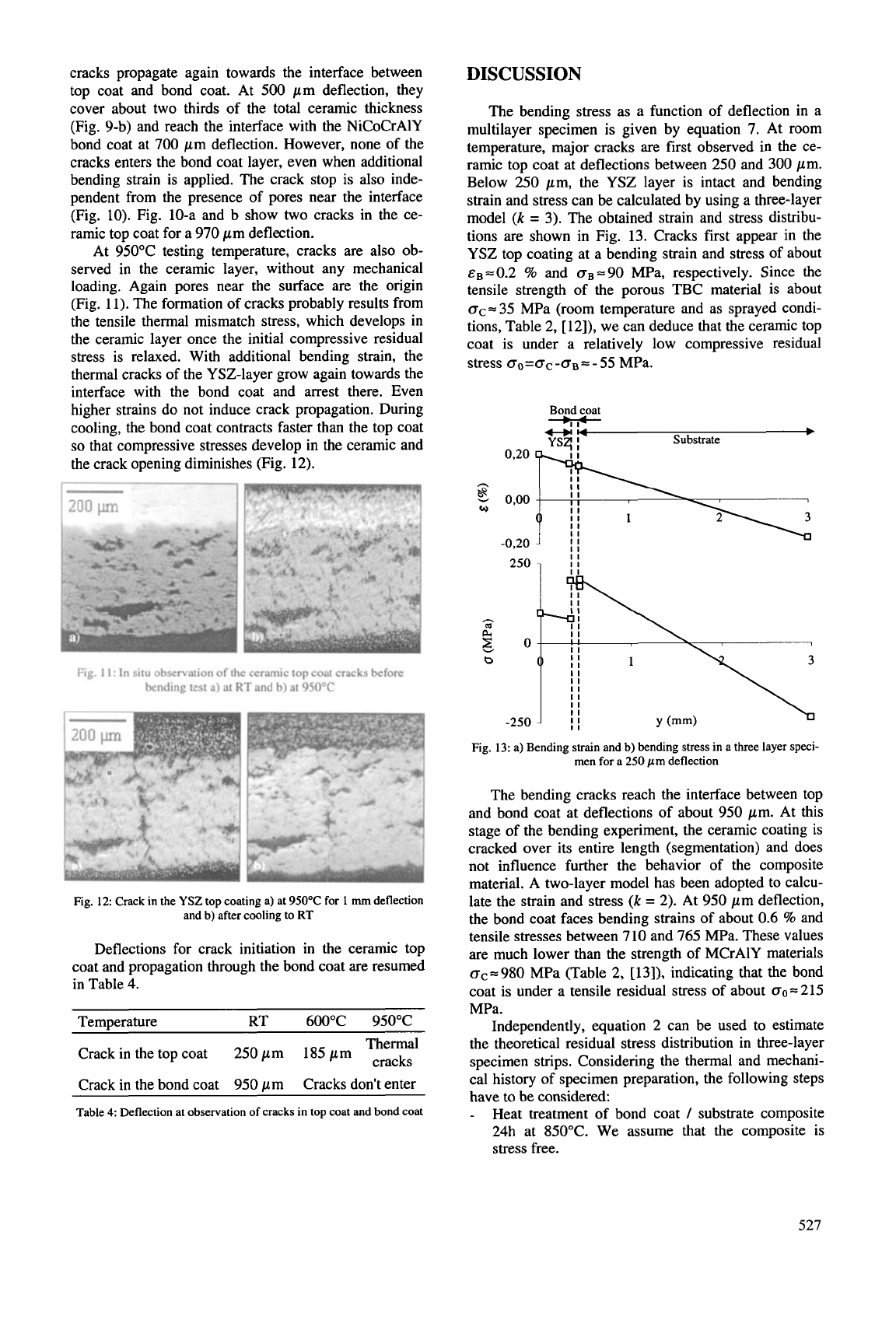
cracks propagate again towards the interface between
top coat and bond coat. At 500 pm deflection, they
cover about two thirds of the total ceramic thickness
(Fig. 9-b) and reach the interface with the NiCoCrAlY
bond coat at 700 pm deflection. However, none of the
cracks enters the bond coat layer, even when additional
bending strain is applied. The crack stop is also inde-
pendent from the presence of pores near the interface
(Fig.
lo).
Fig. 10-a and b show two cracks in the ce-
ramic top coat for a 970 pm deflection.
At 950°C testing temperature, cracks are also ob-
served in the ceramic layer, without any mechanical
loading. Again pores near the surface are the origin
(Fig.
11).
The formation of cracks probably results from
the tensile thermal mismatch stress, which develops in
the ceramic layer once the initial compressive residual
stress is relaxed. With additional bending strain, the
thermal cracks of the YSZ-layer grow again towards the
interface with the bond coat and arrest there. Even
higher strains do not induce crack propagation. During
cooling, the bond coat contracts faster than the top coat
so that compressive stresses develop in the ceramic and
the crack opening diminishes (Fig. 12).
DISCUSSION
The bending stress as a function of deflection in a
multilayer specimen is given by equation
7.
At room
temperature, major cracks are first observed in the ce-
ramic top coat at deflections between 250 and 300 pm.
Below 250
pm,
the YSZ layer is intact and bending
strain and stress can
be calculated by using a three-layer
model
(k
=
3). The obtained strain and stress distribu-
tions are shown in Fig. 13. Cracks first appear in the
YSZ top coating at a bending strain and stress of about
EB=0.2
%
and oB=90 MPa, respectively. Since the
tensile strength of the porous TBC material is about
(TC
=
35 MPa (room temperature and as sprayed condi-
tions, Table 2,
[
12]), we can deduce that the ceramic top
coat is under a relatively low compressive residual
stress
~O=oc
-og
=
-
55
MPa.
0.20
0.00
-0.20
250
Bond coat
-T
Substrate
b
YS?
I
p-
I1
II
II
I1
ii
1
I1
Fig. 11:
In
situ observation of the ceramic top coat cracks before
bending test a) at
RT
and b) at 950°C
-250
Fig.
13:
a) Bending strain and b) bending stress in a three layer
speci-
men for a 250 pm deflection
Fig. 12: Crack in the
YSZ
top coating a) at 950°C for
1
nun
deflection
and b) after cooling to
RT
Deflections for crack initiation in the ceramic top
coat and propagation through the bond coat
are
resumed
in
Table 4.
Temperature RT 600°C 950°C
Crack in the top coat
250 pm
Thermal
185pm
cracks
Crack in the bond coat 950 pm Cracks don't enter
Table
4:
Deflection at observation
of
cracks in top coat and bond coat
The bending cracks reach the interface between top
and bond coat at deflections of about 950
pm.
At this
stage of the bending experiment, the ceramic coating is
cracked over its entire length (segmentation) and does
not influence further the behavior of the composite
material. A two-layer model has been adopted to calcu-
late the strain and stress
(k
=
2). At 950 pm deflection,
the bond coat faces bending strains of about 0.6
%
and
tensile stresses between
7
10 and
765
MPa. These values
are much lower than the strength of MCrAlY materials
oc=980 MPa (Table 2, [13]), indicating that the bond
coat is under a tensile residual stress of about
00~215
MPa.
Independently, equation 2 can be used to estimate
the theoretical residual stress distribution in three-layer
specimen strips. Considering the thermal and mechani-
cal history of specimen preparation, the following steps
have to be considered:
-
Heat treatment of bond coat
/
substrate composite
24h at 850°C. We assume that the composite is
stress free.
527
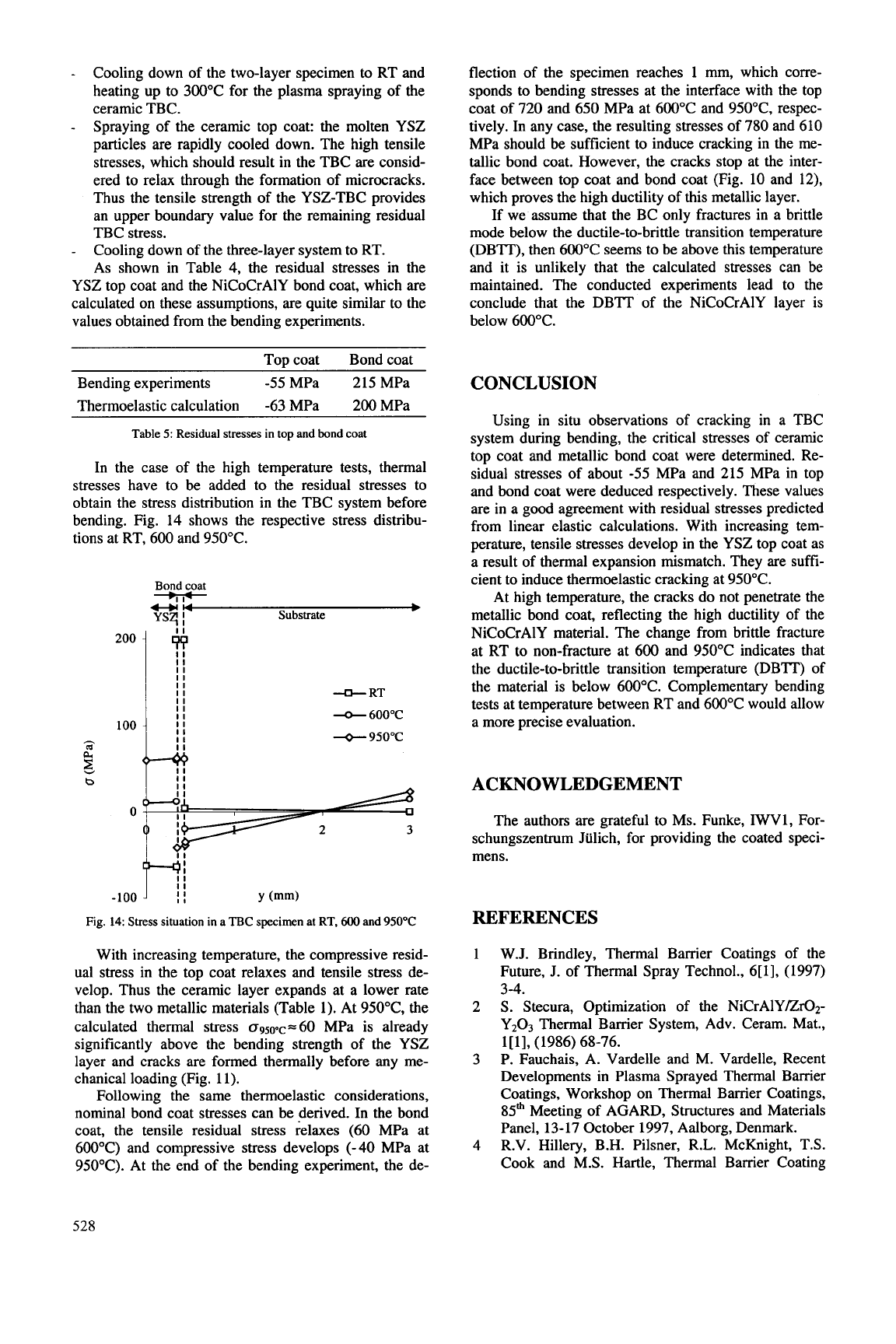
Cooling down of the two-layer specimen to RT and
heating up to 300°C for the plasma spraying of the
ceramic TBC.
Spraying of the ceramic top coat: the molten YSZ
particles are rapidly cooled down. The high tensile
stresses, which should result in the TBC
are
consid-
ered to relax through the formation of microcracks.
Thus the tensile strength of the YSZ-TBC provides
an upper boundary value for the remaining residual
TBC stress.
Cooling down of the three-layer system to RT.
As shown in Table 4, the residual stresses in the
YSZ
top coat and the NiCoCrAlY bond coat, which are
calculated on these assumptions, are quite similar to the
values obtained from the bending experiments.
flection of the specimen reaches 1 mm, which corre-
sponds to bending stresses at the interface with the top
coat of 720 and 650 MPa at 600°C and 950°C respec-
tively. In any case, the resulting stresses of 780 and 610
MPa should be sufficient to induce cracking in the me-
tallic bond coat. However, the cracks stop at the inter-
face between top coat and bond coat (Fig.
10
and 12),
which proves the high ductility of this metallic layer.
If we assume that the BC only fractures in a brittle
mode below the ductile-to-brittle transition temperature
(DBTT), then 600°C seems to be above this temperature
and it is unlikely that the calculated stresses can be
maintained. The conducted experiments lead to the
conclude that the DBTT of the NiCoCrAlY layer is
below 600°C.
Top coat Bond coat
Bending experiments
-55
MPa 215 MPa
Thermoelastic calculation -63 MPa 200 MPa
Table
5:
Residual stresses in top and bond coat
In the case of the high temperature tests, thermal
stresses have to be added to the residual stresses to
obtain the stress distribution in the TBC system before
bending. Fig. 14 shows the respective stress distribu-
tions at RT, 600 and 950°C.
Bond coat
v
Substrate
-4
b
200
-
ii
!!
RT
I1
1
ii
-0-
600°C
-0-
950°C
Fig.
14:
Stress
situation in
a
TBC
specimen at RT.
600
and
950°C
With increasing temperature, the compressive resid-
ual stress in the top coat relaxes and tensile stress de-
velop. Thus the ceramic layer expands at a lower rate
than the two metallic materials (Table
1).
At 950"C, the
calculated thermal stress
(T~~~~~=~O
MPa is already
significantly above the bending strength of the YSZ
layer and cracks are formed thermally before any me-
chanical loading (Fig. 11).
Following the same thermoelastic considerations,
nominal bond coat stresses can be derived. In the bond
coat, the tensile residual stress relaxes
(60
MPa at
600°C) and compressive stress develops
(-40
MPa at
950°C). At the end of the bending experiment, the de-
CONCLUSION
Using in situ observations of cracking in a TBC
system during bending, the critical stresses of ceramic
top coat and metallic bond coat were determined. Re-
sidual stresses of about
-55
MPa and 215 MPa in top
and bond coat were deduced respectively. These values
are in a good agreement with residual stresses predicted
from linear elastic calculations. With increasing tem-
perature, tensile stresses develop in the YSZ top coat as
a result of thermal expansion mismatch. They are suffi-
cient to induce thermoelastic cracking at 950°C.
At high temperature, the cracks do not penetrate the
metallic bond coat, reflecting the high ductility of the
NiCoCrAlY material. The change from brittle fracture
at RT to non-fracture at 600 and 95OOC indicates that
the ductile-to-brittle transition temperature (DBTT) of
the material is below 600°C. Complementary bending
tests at temperature between RT and 600°C would allow
a more precise evaluation.
ACKNOWLEDGEMENT
The authors are grateful to Ms. Funke, IWV1, For-
schungszentrum Jiilich, for providing the coated speci-
mens.
REFERENCES
1
W.J. Brindley, Thermal Barrier Coatings of the
Future, J. of Thermal Spray Technol., 6[1], (1997)
3-4.
S.
Stecura, Optimization of the NiCrA1Y/Zr02-
Yz03 Thermal Barrier System, Adv. Ceram. Mat.,
P. Fauchais, A. Vardelle and M. Vardelle, Recent
Developments in Plasma Sprayed Thermal Barrier
Coatings, Workshop on Thermal Barrier Coatings,
85" Meeting of AGARD, Structures and Materials
Panel, 13-17 October 1997, Aalborg, Denmark.
R.V. Hillery, B.H. Pilsner, R.L. McKnight,
T.S.
Cook and M.S. Hartle, Thermal Barrier Coating
2
I[
11, (1986) 68-76.
3
4
528
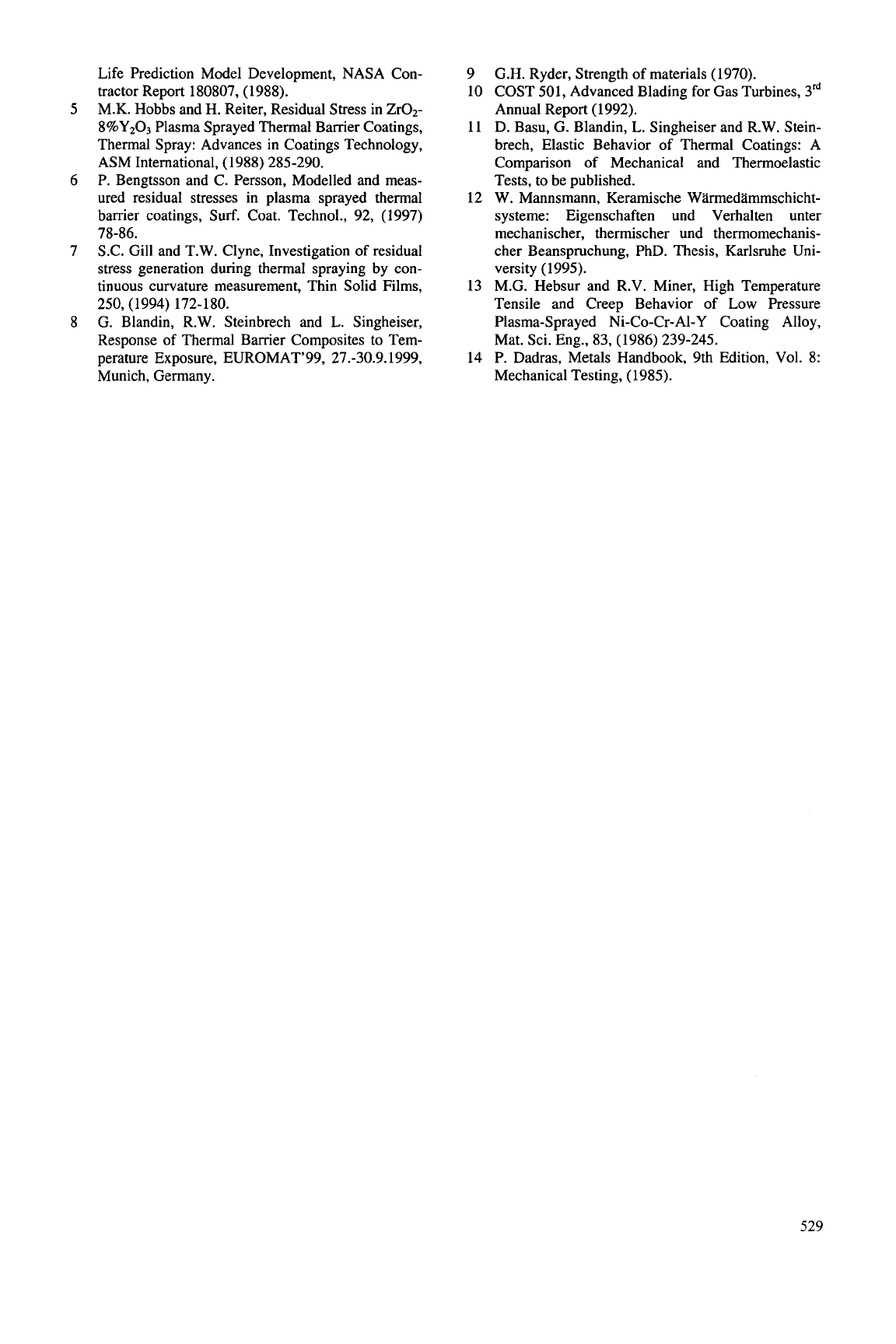
Life Prediction Model Development, NASA Con-
tractor Report
180807, (1988).
M.K. Hobbs and H. Reiter, Residual Stress in ZrOz-
8%Y203
Plasma Sprayed Thermal Barrier Coatings,
Thermal Spray: Advances in Coatings Technology,
ASM International,
(1988) 285-290.
P. Bengtsson and C. Persson, Modelled and meas-
ured residual stresses in plasma sprayed thermal
barrier coatings, Surf. Coat. Technol.,
92, (1997)
S.C. Gill and T.W. Clyne, Investigation of residual
stress generation during thermal spraying by con-
tinuous curvature measurement, Thin Solid Films,
G. Blandin, R.W. Steinbrech and L. Singheiser,
Response of Thermal Barrier Composites to Tem-
perature Exposure, EUROMAT'99,
27.-30.9.1999,
Munich, Germany.
5
6
78-86.
7
250, (1994) 172-180.
8
9
G.H. Ryder, Strength of materials
(1970).
10
COST
501,
Advanced Blading for Gas Turbines,
3rd
Annual Report
(
1992).
11
D. Basu, G. Blandin,
L.
Singheiser and R.W. Stein-
brech, Elastic Behavior
of
Thermal Coatings: A
Comparison of Mechanical and Thermoelastic
Tests, to be published.
12
W. Mannsmann, Keramische Warmedammschicht-
systeme: Eigenschaften und Verhalten unter
mechanischer, thermischer und thermomechanis-
cher Beanspruchung, PhD. Thesis, Karlsruhe Uni-
versity
(1995).
13
M.G. Hebsur and R.V. Miner, High Temperature
Tensile and Creep Behavior of Low Pressure
Plasma-Sprayed Ni-Co-Cr-Al-Y Coating Alloy,
Mat. Sci. Eng.,
83, (1986) 239-245.
14
P. Dadras, Metals Handbook, 9th Edition, Vol.
8:
Mechanical Testing,
(1985).
529

This Page Intentionally Left Blank
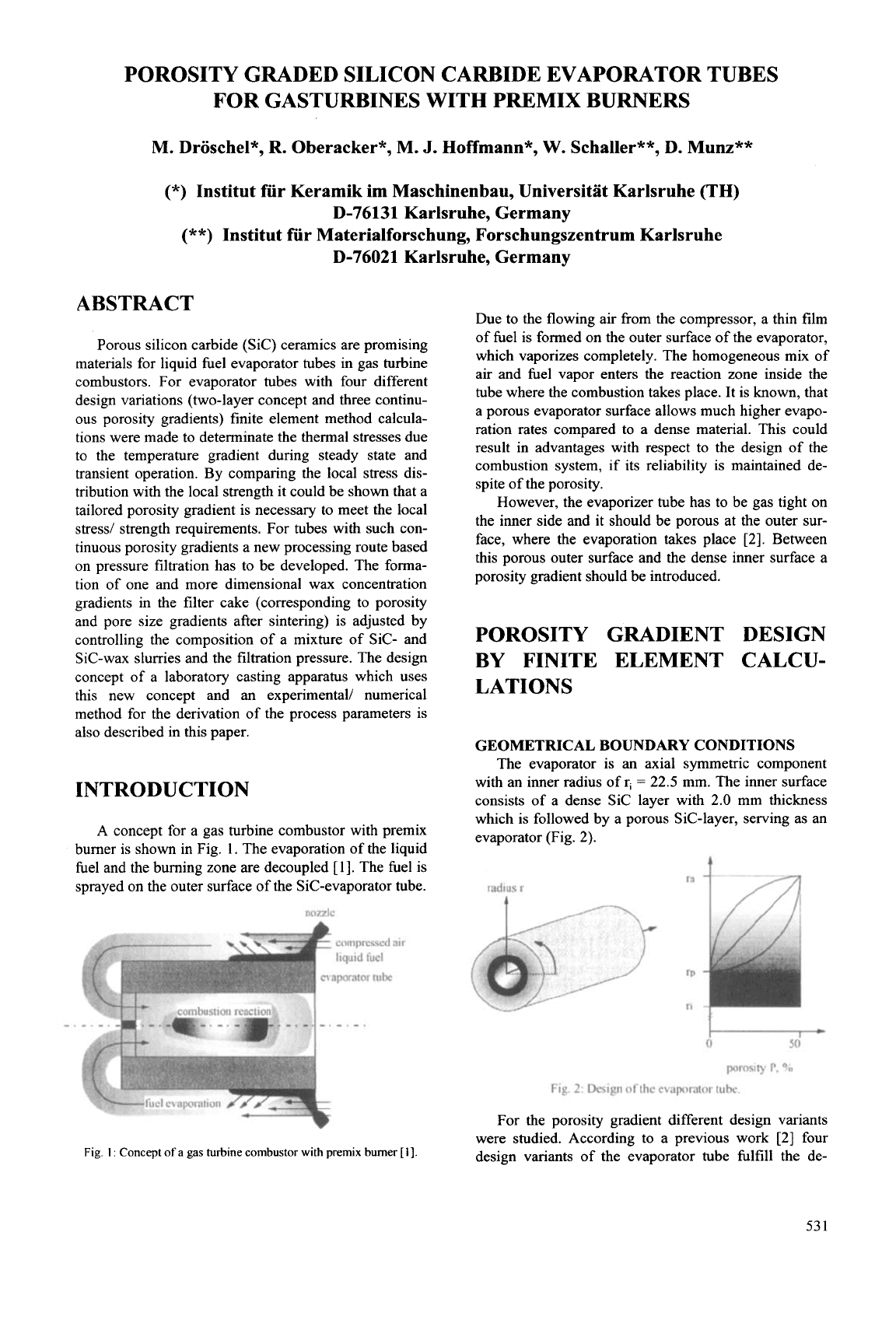
POROSITY GRADED SILICON CARBIDE EVAPORATOR TUBES
FOR GASTURBINES WITH PREMIX BURNERS
M. Droschel",
R.
Oberacker", M.
J.
Hoffmann", W. Schaller**, D. Munz**
(*)
Institut fur Keramik im Maschinenbau, Universitat Karlsruhe
(TH)
D-76131 Karlsruhe, Germany
(**)
Institut fur Materialforschung, Forschungszentrum Karlsruhe
D-76021 Karlsruhe, Germany
ABSTRACT
Porous silicon carbide (Sic) ceramics are promising
materials for liquid fuel evaporator tubes in gas turbine
combustors. For evaporator tubes with four different
design variations (two-layer concept and three continu-
ous porosity gradients) finite element method calcula-
tions were made to determinate the thermal stresses due
to the temperature gradient during steady state and
transient operation. By comparing the local stress dis-
tribution with the local strength it could be shown that a
tailored porosity gradient is necessary to meet the local
stress/ strength requirements. For tubes with such con-
tinuous porosity gradients a new processing route based
on
pressure filtration has to be developed. The forma-
tion of one and more dimensional wax concentration
gradients in the filter cake (corresponding to porosity
and pore size gradients after sintering) is adjusted by
controlling the composition of a mixture of Sic- and
Sic-wax slurries and the filtration pressure. The design
concept of a laboratory casting apparatus which uses
this new concept and an experimental/ numerical
method for the derivation of the process parameters is
also described in this paper.
INTRODUCTION
A concept for a gas turbine combustor with premix
burner is shown in Fig.
1.
The evaporation of the liquid
fuel and the burning zone are decoupled
[
11. The fuel is
sprayed
on
the outer surface of the Sic-evaporator tube.
Due to the flowing air from the compressor, a thin film
of fuel is formed
on
the outer surface of the evaporator,
which vaporizes completely. The homogeneous mix of
air and fuel vapor enters the reaction zone inside the
tube where the combustion takes place. It is known, that
a porous evaporator surface allows much higher evapo-
ration rates compared to a dense material. This could
result in advantages with respect to the design of the
combustion system, if its reliability is maintained de-
spite of the porosity.
However, the evaporizer tube has to be gas tight
on
the inner side and it should be porous at the outer sur-
face, where the evaporation takes place [2]. Between
this porous outer surface and the dense inner surface a
porosity gradient should be introduced.
POROSITY GRADIENT DESIGN
LATIONS
BY FINITE ELEMENT CALCU-
GEOMETRICAL BOUNDARY CONDITIONS
The evaporator is an axial symmetric component
with an inner radius of ri
=
22.5 mm. The inner surface
consists of a dense Sic layer with 2.0 mm thickness
which is followed by a porous Sic-layer, serving as an
evaporator (Fig. 2).
radius
r
nozzle
Fig.
I
:
Concept ofa gas turbine combustor with premix burner
[I].
porosity
P.
"/o
Fig.
2:
Design ofthe evaporator tube.
For the porosity gradient different design variants
were studied. According to a previous work [2] four
design variants of the evaporator tube fulfill the de-
53
1
